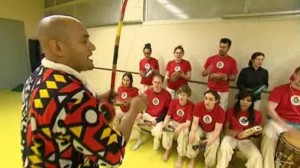Songs are performed in Portuguese. Through the lyrics, nostalgic stories, Masters’ legends linked to Capoeira’s culture are narrated . The songs tell us about the past, the present and the future. Knowledge has been transmitted from a generation to generation, from father/mother to son/daughter, by oral culture and communication. Music creates an atmosphere, an effect that is different from reading a book.
The emotion is palpable at each and every note, the lyrics describe Capoeira’s world and its various groups. Capoeira’s songs are considered as giving at least half of the understanding of the practice. In the roda, the rythms impose the capoeirist’s way of playing, it creates the modifications in the game or special requests of the players.
That’s why it is interesting to learn all the rythms. It is possible to play rythms such as « chula », « corrido » or « ladainha » in both Angola or Regional styles.  You can tell a story, ask for a protection from God, Masters of the past, African divinities (Orixas) or Catholic Saints, following one’s believes. Capoeira is very superstitious. All those songs preserve Capoeira’s history and evolution. In the past, Capoeira was practiced on the beats of drums, but with time passing, it has been subjected to some modifications. Drums (or atabaques) are still played but have lost their importance, giving the main part to the berimbau. Berimbau’s rythms are: Angola, Benguela, São-Bento-Grande, São-Bento-Pequeno and São-Bento da Regional. These are the most frequently played rythms but there are lots others. There is also the « Iuna » rythm, inspired from the love parade of the Iuna bird. The huge diversity of the rythms are a proof of this art’s incalculable wealthness.
You can tell a story, ask for a protection from God, Masters of the past, African divinities (Orixas) or Catholic Saints, following one’s believes. Capoeira is very superstitious. All those songs preserve Capoeira’s history and evolution. In the past, Capoeira was practiced on the beats of drums, but with time passing, it has been subjected to some modifications. Drums (or atabaques) are still played but have lost their importance, giving the main part to the berimbau. Berimbau’s rythms are: Angola, Benguela, São-Bento-Grande, São-Bento-Pequeno and São-Bento da Regional. These are the most frequently played rythms but there are lots others. There is also the « Iuna » rythm, inspired from the love parade of the Iuna bird. The huge diversity of the rythms are a proof of this art’s incalculable wealthness.
In the practice of Capoeira, instruments and songs cannot be set apart. It is always linked to its history and represents Capoeira’s artistic part.




